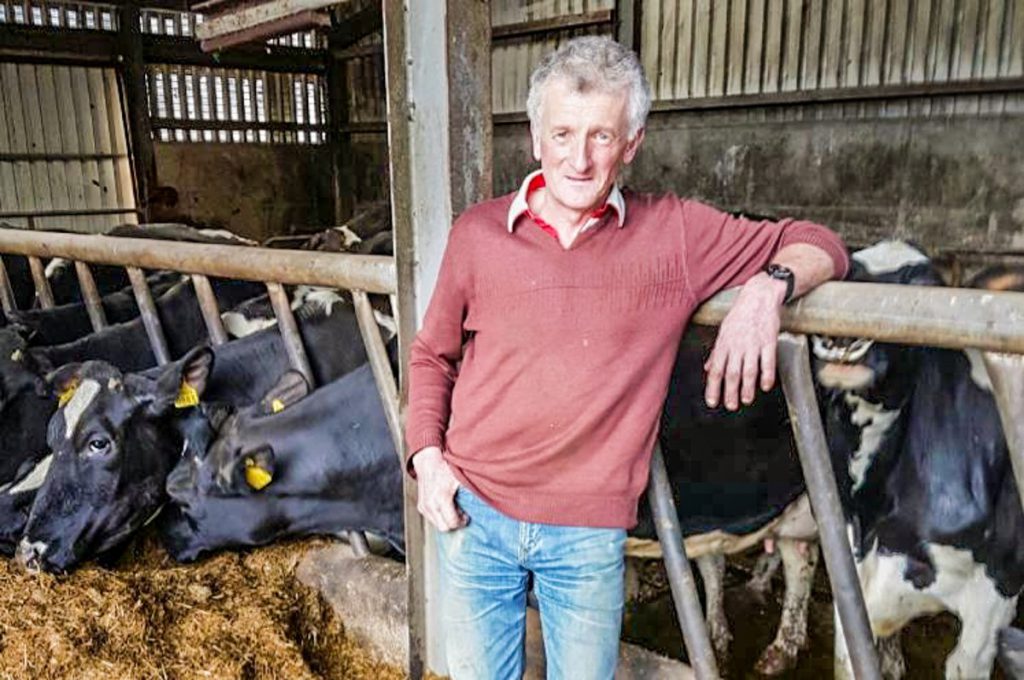Dairy farmer John P. Galvin milks 80 cows in a compact spring-calving system overlooking the Dingle Peninsula in Lispole, Co. Kerry.
Galvin’s land goes right down to the Atlantic Ocean and receives 1,600-1,700mm of rainfall on an annual basis.
Last year, John sold 477kg of milk solids from each cow in his herd to the Kerry Group at 4.22% fat and 3.62% protein.
The herd also featured in the recent top 200 EBI herds in Ireland, sitting in 149th place, with a herd EBI of €129. The herd’s EBI is balanced between milk (€44), fertility (€51) and calving (€33).
Focusing on heat detection
John uses the Munster AI technician service and combines the fresh semen programme with the year one genomic tested sires.
The AI technician, via his handheld, ensures that no inbreeding occurs.
This service allows John to concentrate solely on heat detection during the breeding season – knowing that he is receiving the very best genetics available, from a highly skilled Munster AI technician, and completely avoiding inbreeding.
The genetic progress being made is evident from the EBI graph.
Impressive fertility performance
The fertility performance of the herd is impressive, with over 85% of the herd calving in just six weeks.
This is achieved through a high submission rate, due to excellent heat detection and a high conception from the AI technician.
John’s heat detection is exceptional; scratch cards are used on the heifers. Cows not detected in heat three weeks into the breeding season are examined and treated.
John monitors the health status of his herd and the efficacy of his vaccination and parasite control programme annually, through the Munster Herd Health programme.
He finds the end-of-year meeting with the Munster vet invaluable, for reviewing his performance and helping him with decisions in which he plans the dry period and the year ahead.
For the past two years, he has carried out Johnes Disease screening through milk recording.
Both these programmes ensure that output is maintained each year and that high genetic breeding stock, with a high health status, can be sold off the farm.
A combination of genetics, health and compact calving
The Kerry-based dairy farmer attributes the performance of his herd to their genetics, health and a compact spring-calving pattern.
Performance is monitored by monthly milk recording from February to November. John is now firmly of the opinion that each cow needs to be contributing to the bottom line – for him to maximise his profitability.
The real profit drivers are the mature third lactation plus cows, calving in February.
A feature of the herd is the consistent level of production between the cows, with no poor performers.
The first milk recording of 2017 was completed on March 7. This allows the early identification of any SCC issues and their immediate correction.
This, in turn, allows all cows to reach their full potential over the lactation period.
Selling surplus
As all cows and heifers are bred to dairy sires, John has surplus heifers to sell each year as calves, maidens or in-calf heifers.
One can have confidence that these high genetic merit heifers from a high health status herd will perform and remain in the herd for a long time for their new owners.
John has bred a few bulls that have entered AI; the most popular being JKF – (IG) Doonmanagh Jacko – an FLT son from a great DEU cow.
He is looking forward to producing a genetic gem from his herd on the Dingle peninsula – an area that has produced so many footballing legends down through the years.
To find out more about the services offered by Munster AI: Click Here




